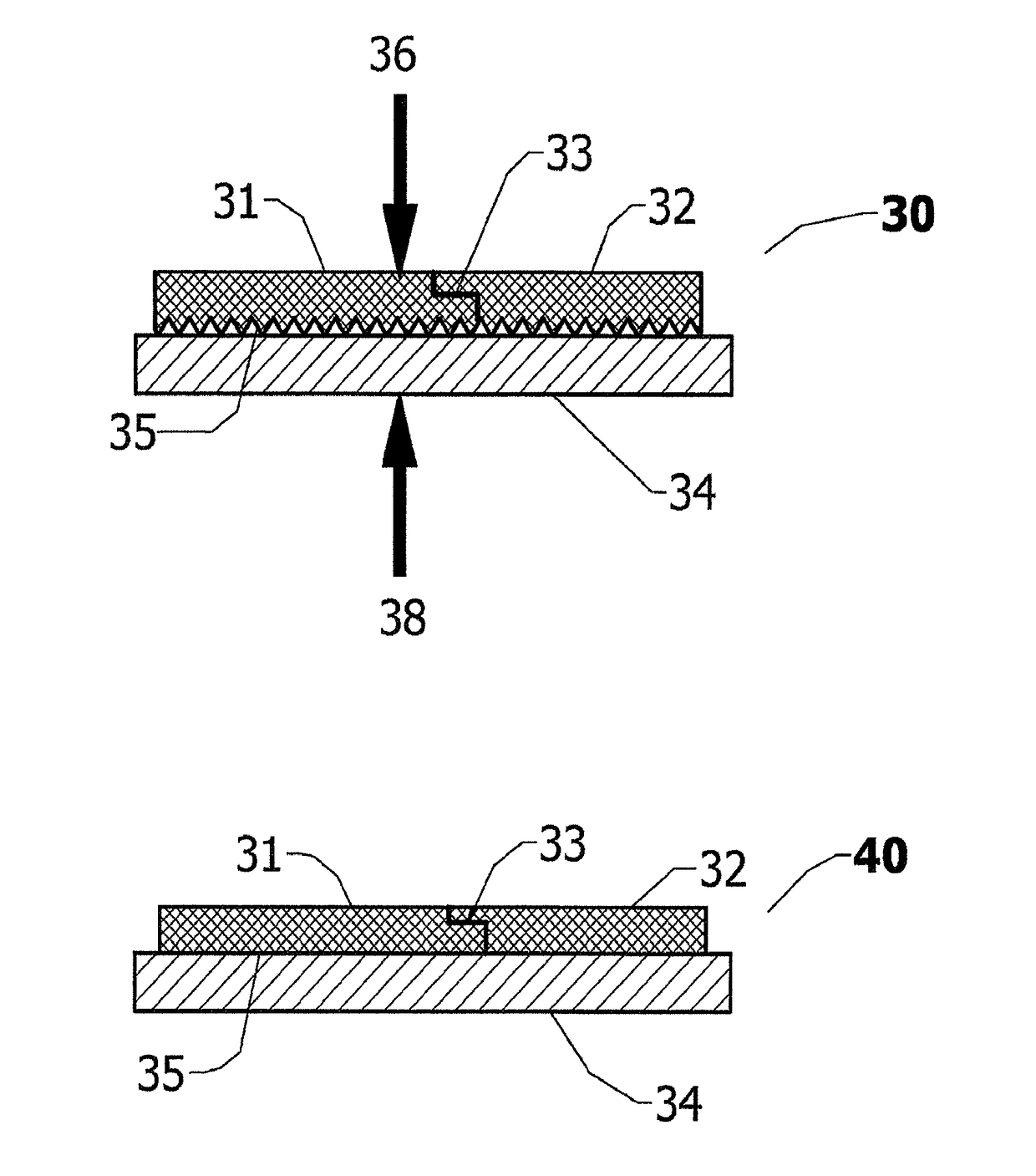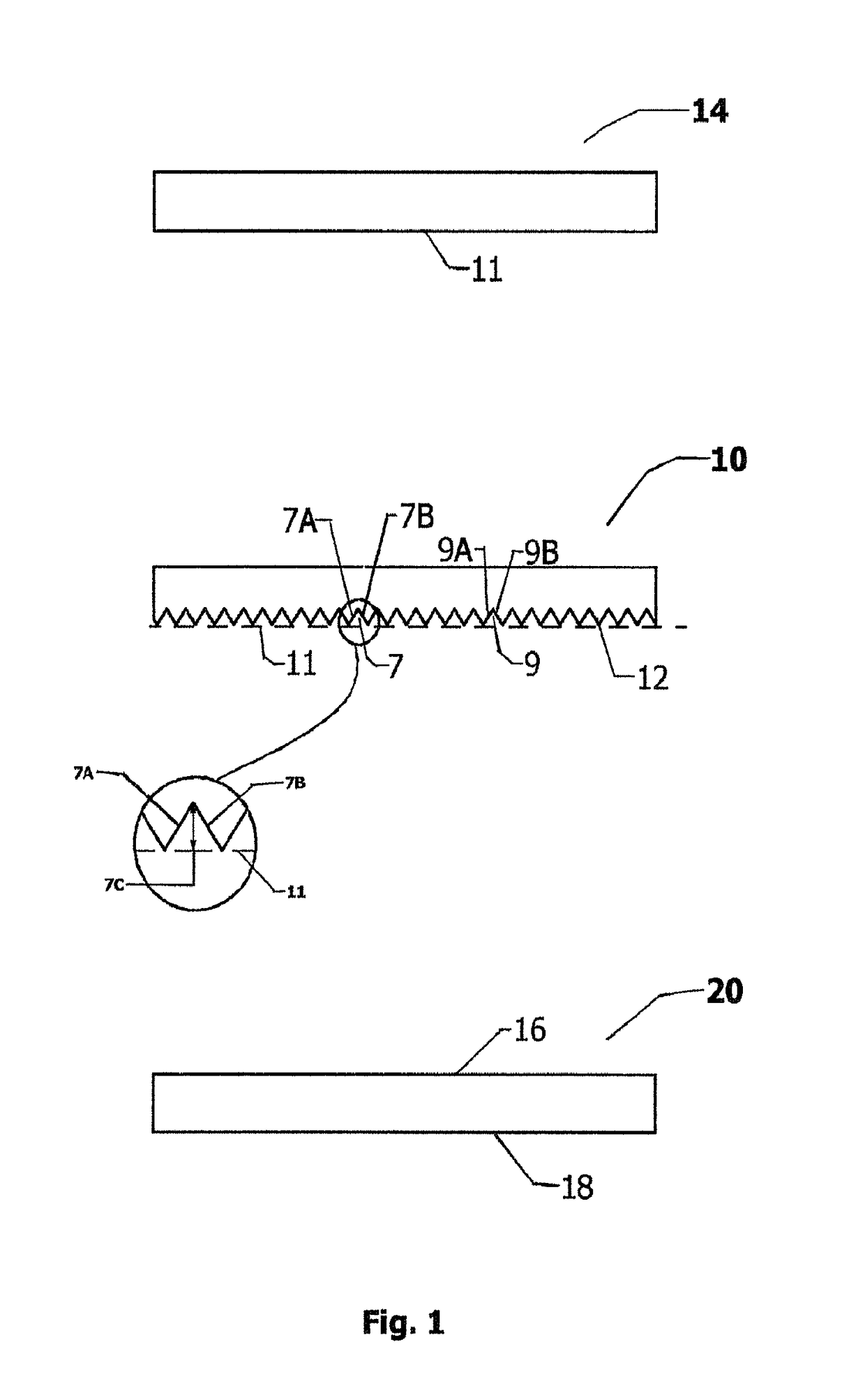Processes for Low Pressure, Cold Bonding of Solid Lithium to Metal Substrates
a technology of solid lithium and metal substrates, applied in vacuum evaporation coating, non-electric welding apparatus, manufacturing tools, etc., can solve the problems of reducing the pressure required and affecting the quality of etc., to achieve the effect of reducing the pressure needed to bond the solid lithium surface to the metal substrate surface, facilitating the flow of lithium, and increasing material flow
- Summary
- Abstract
- Description
- Claims
- Application Information
AI Technical Summary
Benefits of technology
Problems solved by technology
Method used
Image
Examples
example 1
[0021]In accordance with this invention, two plates of lithium, 13 mm thick×149 mm wide, were extruded with a furrowed surface on one side and a step along both edges as shown in FIG. 2. The furrows (a.k.a., indentions) had a depth of 3 mm. The two plates were adjoined to form a lap joint by overlapping the stepped edges creating an assembly that is 282 mm wide. The furrowed side was placed against a 9 mm thick 304 stainless steel substrate. The stainless steel substrate was cleaned by buffing with a SCOTCH-BRITE pad followed by wiping with a clean cloth dampened with hexane just prior to laying the lithium plate against it. The assembly was positioned between platens of a hydraulic press and progressively pressed with 100 mm long bites at a force of 44,482 N generating a stress on the lithium of 1.6 N / mm2 (1.6 MPa). The pressing reduced the lithium thickness to 11.3 mm. Pressing was done within 4 hours of extruding the lithium to minimize surface oxidation. All processes were perfo...
example 2
[0022]In accordance with this invention, two, 10.4 mm thick×149 mm wide, plates of lithium were extruded with a furrowed surface on one side and a step, 6 mm×5 mm deep, along both edges. The furrows (a.k.a., indentions) had a depth approximately 3 mm. The steps along the edges allowed the two plates to be adjoined in a manor to form a lap joint and thus create a plate approximately 282 mm wide. The furrowed side was placed against a 9 mm thick titanium substrate. The titanium substrate was cleaned by buffing with a SCOTCH-BRITE pad followed by wiping with a clean cloth dampened with hexane just prior to laying the lithium plate against it. The lithium / titanium plate assembly was heated to 60° C. by an electrically heated aluminum support plate. The entire assembly was positioned between platens of a hydraulic press and progressively pressed with 100 mm long bites at a force of 44,482 N generating a stress on the lithium of 1.6 N / mm2 (1.6 MPa). All processes were performed in a dry r...
example 3
[0023]In accordance with this invention, two, 17.1 mm thick×96 mm wide, plates of lithium were extruded with a furrowed surface on one side and a step, 3.2 mm×8.5 mm deep, along both edges. The furrows (a.k.a., indentions) had a depth approximately 3 mm. The steps along the edges allowed the two plates to be adjoined in a manor to form a lap joint and thus create a plate approximately 192 mm wide. The furrowed side was placed against a 9.5 mm thick copper substrate. The copper substrate was cleaned by buffing with a clean cloth dampened with hexane just prior to laying the lithium plate against it. The entire assembly was positioned between platens of a hydraulic press and progressively pressed with 100 mm long bites at a force of 105,000 N generating a stress on the lithium of 5.4 N / mm2 (5.4 MPa). All processes were performed in a dry room at 20° C. with a dew point of <−35° C. Pressing was done within 4 hours of extruding the lithium to minimize surface oxidation. The resulting pl...
PUM
| Property | Measurement | Unit |
|---|---|---|
| Temperature | aaaaa | aaaaa |
| Temperature | aaaaa | aaaaa |
| Fraction | aaaaa | aaaaa |
Abstract
Description
Claims
Application Information
 Login to View More
Login to View More - R&D
- Intellectual Property
- Life Sciences
- Materials
- Tech Scout
- Unparalleled Data Quality
- Higher Quality Content
- 60% Fewer Hallucinations
Browse by: Latest US Patents, China's latest patents, Technical Efficacy Thesaurus, Application Domain, Technology Topic, Popular Technical Reports.
© 2025 PatSnap. All rights reserved.Legal|Privacy policy|Modern Slavery Act Transparency Statement|Sitemap|About US| Contact US: help@patsnap.com



